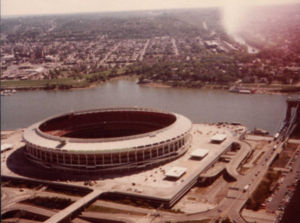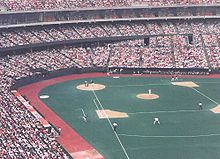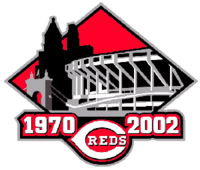- Riverfront Stadium
-
For the Riverfront Stadium located in Newark, New Jersey, see Bears & Eagles Riverfront Stadium. For the arena in Iowa, see Riverfront Stadium (Waterloo).
Riverfront Stadium-Cinergy Field 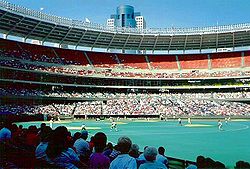
Riverfront Stadium in 1992Former names Riverfront Stadium (1970-1995)
Cinergy Field (1996-2002)Location 201 East Joe Nuxhall Way, Cincinnati, Ohio 45202 Coordinates 39°5′48″N 84°30′30″W / 39.09667°N 84.50833°WCoordinates: 39°5′48″N 84°30′30″W / 39.09667°N 84.50833°W Broke ground February 1, 1968 Opened June 30, 1970 Closed December 12, 1999 (NFL), September 22, 2002 (MLB) Demolished December 29, 2002 Owner City of Cincinnati Surface AstroTurf 8 (1970–2000)
Grass (2001–2002)Construction cost $45 million
($255 million in 2011 dollars[1])Architect Heery & Heery
FABRAPCapacity 1970-2000
52,952 Baseball
59,754 Football
2001-2002 - 39,000Field dimensions 1970-2000
Left field - 330 ft (100 m)
Left-center field - 375 ft (114 m)
Center field - 404 ft (123 m)
Right-center field - 375 ft (114 m)
Right field - 330 ft (100 m)
Backstop - 51 ft (16 m)
2001-2002
Left field - 325 ft (99 m)
Left-center field - 370 ft (110 m)
Center field - 393 ft (120 m)
Right-center field - 373 ft (114 m)
Right field - 325 ft (99 m)
Backstop - 41 ft (12 m)Tenants Cincinnati Bengals (NFL) (1970-1999)
Cincinnati Reds (MLB) (1970-2002)
Cincinnati Bearcats (1990)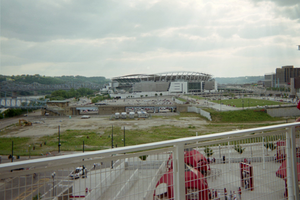 The Riverfront Stadium site in June, 2006. This photo was taken from the western concourse of Great American Ball Park. A small portion of the Riverfront Stadium site is now occupied by the Reds' Hall of Fame and Museum and Main Street, which was extended when the new park was built. The Cincinnati Bengals' Paul Brown Stadium is in the distance.
The Riverfront Stadium site in June, 2006. This photo was taken from the western concourse of Great American Ball Park. A small portion of the Riverfront Stadium site is now occupied by the Reds' Hall of Fame and Museum and Main Street, which was extended when the new park was built. The Cincinnati Bengals' Paul Brown Stadium is in the distance.
Riverfront Stadium (1970–1995), later known as Cinergy Field (1996–2002), was the home of the Cincinnati Reds National League baseball team and the Cincinnati Bengals National Football League team. Located on the Ohio River in downtown Cincinnati, the stadium was best known as the home of "The Big Red Machine," as the Reds were often called in the 1970s. Construction began on February 1, 1968 and was completed at a cost of less than $50 million. On June 30, 1970, the Reds hosted the Atlanta Braves in their grand opening, with Hank Aaron hitting the first ever home run at Riverfront. Two weeks later on July 14, Riverfront hosted the 1970 Major League Baseball All-Star Game. This game is best remembered for the often-replayed collision at home plate between Reds star Pete Rose and catcher Ray Fosse of the Cleveland Indians.
In September 1996, Riverfront Stadium was renamed "Cinergy Field" in a sponsorship deal with Greater Cincinnati's energy company, Cinergy Corporation. In 2001, to make room for Great American Ball Park, the seating capacity at Cinergy Field was reduced to 39,000. There was a huge wall in Center Field visible after the renovations, to serve as the batter's eye. The stadium was demolished by implosion on December 29, 2002.
Contents
History
"Cookie-Cutters"
Riverfront was a multi-purpose, circular "cookie-cutter" stadium, one of many built in the United States in the late 1960s and early 1970s as communities sought to save money by having their football and baseball teams share the same facility. Riverfront, Busch Stadium in St. Louis, Atlanta-Fulton County Stadium in Atlanta, Jack Murphy in San Diego, Three Rivers Stadium in Pittsburgh, Shea Stadium in New York, RFK Stadium in Washington, D. C., and Veterans Stadium in Philadelphia all opened within a few years and were largely indistinguishable from one another; in particular, it was often confused with fellow Ohio River cookie-cutter Three Rivers Stadium by sportscasters because of the two stadium's similar names and similar designs.
The site on which Riverfront Stadium sat originally included the 2nd Street tenement, birthplace and boyhood home of cowboy singer and actor Roy Rogers, who joked that he was born "somewhere between second base and center field."
Big Red Machine
Riverfront Stadium quickly earned a place in Cincinnati's century-long baseball tradition as the home of one of the best teams in baseball history. The World Series had visited the Reds' previous home, Crosley Field, just three times in its final 31 years, (1939, 1940, 1961) but it came to Riverfront in its first year (1970) and a total of four times in the stadium's first seven years, with the Reds winning back-to-back championships in 1975 and 1976. The World Series would return in 1990, with Cincinnati winning the first two of a four-game sweep of the Oakland Athletics at Riverfront.
Baseball purists disliked Riverfront's artificial turf, but Reds' Manager Sparky Anderson and General Manager Bob Howsam took advantage of it by encouraging speed and line drive hitting that could produce doubles, triples and high-bouncing infield hits. Players who combined power and speed like Joe Morgan, Pete Rose and Ken Griffey, Sr. thrived there. On defense, the fast surface and virtually dirtless infield (see photo) rewarded range and quickness by both outfielders and infielders, like shortstop Dave Concepción who used the turf to bounce many of his long throws to first. Catcher Johnny Bench and first baseman Tony Perez played here. The artificial turf covered not only the normal grass area of the ballpark but is usually the "skinned" portion of the infield. Only the pitcher's mound, the home plate area, and cutouts around first, second and third bases had dirt surfaces. This was the first stadium in the majors with this "sliding pit" configuration. The new stadiums that would follow (Veterans Stadium, Royals Stadium, Kingdome, Hubert H. Humphrey Metrodome, Skydome) would install sliding pits as the original layout, and the existing artificial turf fields in San Francisco, Houston, Pittsburgh, and St. Louis would change to the cut-out configuration within the next few years.
Riverfront hosted the MLB All-Star Game twice. First in 1970 with President Richard Nixon in attendance, and again in 1988.
Professional football
Despite Cincinnati's love of baseball, it was the prospect of a professional football team that finally moved the city to end twenty years of discussion and build a new stadium on the downtown riverfront. After playing for two seasons at Nippert Stadium on the University of Cincinnati campus, the Bengals built on the Reds' success in the stadium's first year when they recorded their first winning season and first playoff appearance in 1970, just their third year of existence.
Perhaps the most memorable football game at Riverfront was the AFC Championship on January 10, 1982. The game became known as the Freezer Bowl and was won by the Bengals over the San Diego Chargers, 27-7. The air temperature during the game was −9 °F (−23 °C) and the wind chill was −59 °F (−51 °C), the coldest in NFL history. The win earned the Bengals their first of two trips to the Super Bowl (XVI) while playing at Riverfront.
Riverfront Stadium hosted the 1988 AFC Championship, as the Bengals beat the Buffalo Bills 21–10 to advance to their second Super Bowl appearance.
During the Bengals' tenure, they posted a 5-1 record in playoff games played in Riverfront Stadium, with victories over the Buffalo Bills (twice), San Diego Chargers, Seattle Seahawks, and Houston Oilers. Their only home playoff loss came to the New York Jets.
College football
In the 1980s, Riverfront Stadium also hosted University of Cincinnati football games. Among the Bearcats' opponents were the University of Alabama, Boston College and Penn State University, whose 1985 game took place with the Nittany Lions number one in the coaches' poll.
Baseball-only
When the Bengals moved to Paul Brown Stadium in 2000, the Reds were left as Cinergy Field's only tenant. Prior to the 2001 baseball season, the stadium was remodeled into a baseball-only configuration, and the artificial surface was replaced with grass. To allow room for the construction of Great American Ball Park (which was being built largely over the grounds the stadium already sat on), a large section of the left and center field stands were removed and the distance to the fences was shortened by five feet. The new Great American Ballpark and old Riverfront Stadium were 26 inches apart at its closest point during this time. Consequently, in its last years, the stadium achieved an openness and a degree of aesthetic appeal that it had lacked for most of its existence. In the Reds' final two seasons in the stadium, ongoing construction on Great American was plainly visible just beyond the outfield walls while the team played their games.
Seating Capacity
Baseball
51,500 (1970)
51,744 (1971)
51,726 (1972-1974)
51,786 (1975-1983)
52,392 (1984-1991)
52,952 (1992-2000)
40,007 (2001-2002)Football
56,200 (1970-1980)[2]
59,754 (1981-1991)[3]
60,389 (1992-1999)Milestones
Baseball
- First stadium to have its entire field covered by AstroTurf, except for the cutouts around the bases and pitcher’s mound.
- First hit: Félix Millán, June 30, 1970.
- First home run: Hank Aaron, June 30, 1970.
- First Presidential Visit: Richard Nixon, July 14, 1970.
- First upper deck home run: Tony Perez, August 11, 1970.
- First World Series game ever played on artificial turf: October 10, 1970 (Reds vs. Baltimore Orioles).
- First no-hitter: Ken Holtzman, June 3, 1971.
- First pitcher ever to pitch a No-hitter and hit two Home runs in the same game: Rick Wise, June 23, 1971.
- Hank Aaron ties the all-time home run record with number 714: April 4, 1974.
- First stadium to display Metric distances on the outfield walls (100.58 meters down the lines, 114.30 to the alleys, 123.13 to center): 1976.
- Highest season attendance, 2,629,708: 1976.
- First rain checks issued: August 30, 1978.
- First player to Hit for the Cycle: Mike Easler, June 12, 1980.
- Pete Rose breaks the all-time hit record with number 4,192: September 11, 1985.
- First player ever to be caught stealing four times in one game: Robby Thompson, June 27, 1986.
- Perfect Game: Tom Browning, September 16, 1988.
- Umpire John McSherry collapsed and died on April 1, 1996.
- Longest home run, 473': Mark McGwire, May 5, 2000.
Football
- First Touchdown: Sam Wyche, September 20, 1970
- First Field goal: Horst Muhlmann, September 20, 1970
- Freezer Bowl: Lowest wind chill game (2nd lowest temperature) in NFL history, January 10, 1982
- Corey Dillon breaks the single-game rookie rushing record with 246 yards on December 4, 1997.
Concerts
- The Eagles - Hotel California Tour, with Eddie Money & The Steve Miller Band - August 16, 1978 (51,855 people attended)
- The Rolling Stones - Steel Wheels Tour, with Living Colour - September 14, 1989 (55,155 people attended) & Voodoo Lounge Tour, with Lenny Kravitz - August 30, 1994 (34,137 people attended)
- New Kids on the Block - The Magic Summer Tour - July 10, 1990 (48,000 people attended)
- Paul McCartney - The New World Tour - May 5, 1993 (35,342 people attended)
- Asleep at the Wheel, Lee Ann Womack, Mark Chesnutt, Kenny Chesney, Martina McBride & George Strait - May 21, 2000 (42,000 people attended)
- 'N Sync - No Strings Attached Tour, with Sisqo & P!nk - July 14, 2000 (48,234 people attended) & Pop Odyssey Tour, with Dream - June 6, 2001 (35,000 people attended)
In addition, the Kool Jazz Festival (now the Macy's Music Festival) was an annual fixture.
Religious gatherings
- The Jehovah's Witnesses hosted three conventions in the stadium, in 1971, 1974 and 1978.
- Promise Keepers held a meeting there in 1997.
References
- Dittmar, Joseph J. (1997). Baseball Records Registry: The Best and Worst Single-Day Performances and the Stories Behind Them. McFarland & Company. ISBN 0-7864-0293-8
- Munsey & Suppes (1996–2004). Riverfront Stadium. Ballparks.
- Smith, Ron (2000). Riverfront Stadium. The Ballpark Book. The Sporting News. ISBN 0-89204-703-8
- Riverfront Stadium Opens. BaseballLibrary.com.
- ^ Consumer Price Index (estimate) 1800–2008. Federal Reserve Bank of Minneapolis. Retrieved December 7, 2010.
- ^ "Capsule Preview of NFL Games". Boston Globe. September 19, 1970. http://pqasb.pqarchiver.com/boston/access/1946801702.html?FMT=ABS&FMTS=ABS:AI&type=historic&date=Sep+19%2C+1970&author=&pub=Boston+Globe+(1960-1979)&desc=CAPSULE+PREVIEW+OF+NFL+GAMES&pqatl=google.
- ^ "Expect Good Game". Bryan Times. Januray 9, 1982. http://news.google.com/newspapers?id=0p9PAAAAIBAJ&sjid=u1EDAAAAIBAJ&pg=6136,590926&dq=riverfront+stadium+59754&hl=en.
External links
- A Farewell to Cinergy Field. MLB.com.
- Cinergy Field: Kiss it Goodbye. Cincinnati.com.
- Riverfront Stadium/Cinergy Field. Ballparks of Baseball.
- Riverfront Stadium/Cinergy Field. Stadiums of Pro Football
- Cinergy Field. BaseballLibrary.com.
See also
Events and tenants Preceded by
Nippert StadiumHome of the
Cincinnati Bengals
1970–1999Succeeded by
Paul Brown StadiumPreceded by
Crosley FieldHome of the
Cincinnati Reds
1970–2002Succeeded by
Great American Ball ParkPreceded by
RFK Stadium
Oakland-Alameda County ColiseumHost of the All-Star Game
1970
1988Succeeded by
Tiger Stadium
Anaheim StadiumPreceded by
Jack Murphy Stadium
Mile High StadiumHost of AFC Championship Game
1982
1989Succeeded by
Miami Orange Bowl
Mile High StadiumCincinnati Bengals Founded in 1968 · Based in Cincinnati, Ohio The Franchise Stadiums Rivalries Cleveland Browns · Pittsburgh SteelersCulture and Lore Freezer Bowl · Ickey ShuffleHead Coaches Division Championships (7) Super Bowl Appearances (2) Retired Numbers 54Seasons Current League Affiliations League: National Football League · Conference: American Football Conference · Division: North DivisionCincinnati Reds Formerly the Cincinnati Red Stockings and the Cincinnati Redlegs • Based in Cincinnati, Ohio Franchise History · Seasons · Records · No-hitters · Awards · Players · Managers · Owners and executives · Broadcasters · Opening Day starting pitchers · Hall of Fame · Uniforms · Radio · First-round draft picksBallparks Bank Street Grounds · League Park · League Park II · Palace of the Fans · Crosley Field · Riverfront Stadium · Great American Ball Park
Spring Training: Riverside Park • Tinker Field • Sixto Escobar Stadium · Plant Field · Al Lopez Field · Plant City Stadium · Ed Smith Stadium · Goodyear BallparkCulture Mr. Red · The Big Red Machine · The Nasty Boys · Dowd Report · 1999 National League Wild Card tie-breaker gameRivalries Retired Numbers Key Personnel Championships (5) National League
Pennants (9)Other Titles Minors Louisville Bats (AAA) · Carolina Mudcats (AA) · Bakersfield Blaze (A) · Dayton Dragons (A) · Billings Mustangs (Rookie) · AZL Reds (Rookie) · DSL Reds (Rookie) · VSL Reds (Rookie)Media Seasons (129) 1880s-1890s 1900s-1910s 1920s-1930s 1940s-1950s 1960s-1970s 1980s-1990s 2000s-2010s Categories:- Cincinnati Bengals stadiums
- Cincinnati Reds stadiums
- Multi-purpose stadiums in the United States
- Defunct National Football League venues
- Defunct Major League Baseball venues
- Demolished sports venues in the United States
- Sports venues in Cincinnati, Ohio
- 1970 establishments
- Buildings and structures completed in 1970
- 2002 disestablishments
- Baseball venues in Ohio
- American football venues in Ohio
Wikimedia Foundation. 2010.

